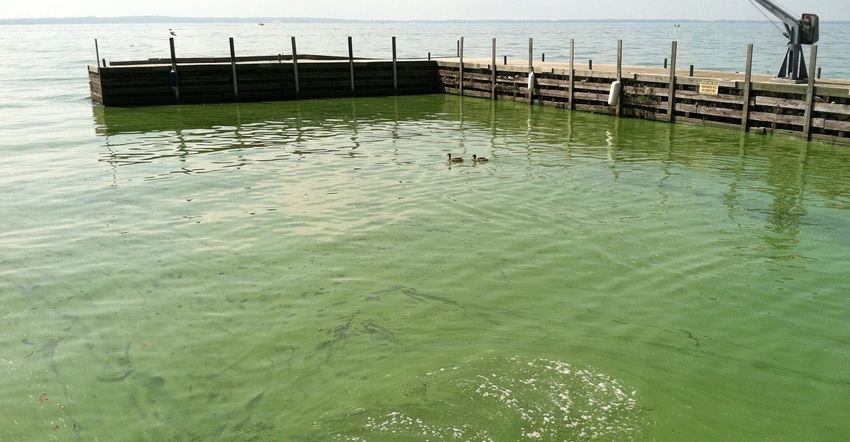April 26, 2021

Agricultural nutrient use is critical to produce a healthy, high-yielding crop. Nitrogen, phosphorus and potassium are the foundation of a crop fertility program.
We look for ways though 4R nutrient stewardship to manage the rate, placement, timing and source to maximize uptake. Yet we still have a ways to go in applied nutrient utilization. We still are only getting 30% to 50% of applied nutrient in the plant.
If those leftover nutrients are soil stable, at least they are there for a future crop. But nutrients, or at least a portion, are not soil stable. We have a small amount of phosphorus, and a relatively larger amount of nitrogen, that leach out of the soil.
There’s the rub. The accumulation of N and P in downstream waters can cause water quality concerns from excessive plant growth. We hear frequently about Lake Erie’s harmful algae blooms, and to a lesser extent, the Gulf of Mexico’s hypoxic zone in relation to N and P effects.
How was the 2020 season for these two water bodies, and what can agriculture do to better to reduce our portion of N and P contributions?
The 2020 Lake Erie bloom had a severity index of 3.0 on a 10-point scale used to measure bloom coverage. The 3.0 bloom size in 2020 is the target we would like to attain each year. In fact, the bloom index for three out of the past five years has been near that 3.0 target. The other two out of five have been near 8.0.
Progress came from ag practices implemented in the basin, we hope, but precipitation swings also are playing a role. Currently, 2011 and 2015 were years that represent the maximum bloom coverage — with 2011 having a severity of 10.0; 2015 was the highest severity at 10.5.
The Gulf of Mexico hypoxic zone in 2020 was 2,116 square miles. Yes, the Gulf of Mexico is not tracked as an index, but the square miles of water with oxygen levels measuring less than 3 parts per million is. The most recent five-year average is 5,770 square miles, which is three times the 2035 goal of 1,930 square miles.
For perspective, the state of Ohio is 44,825 square miles, thus the five-year average gulf hypoxic area would cover 13% of the state, or about 10 counties. The extent of the Gulf of Mexico watershed into the central U.S. continues to be a large challenge.
For both Lake Erie and the Gulf of Mexico, nitrogen and phosphorus targeted reductions are 40% to reach water-quality targets. Some details of the 40% reduction vary by nutrient for each water body, but 40% is an easy to remember number.
Do your part
What can agriculture do to reduce its nitrogen and phosphorus losses? Most farmers I know think that would be a good thing anyway, since the nutrient is already paid for. Why send them downstream?
Nitrogen management is the trickiest of the two. Corn nitrogen deficiency is very visible with leaf firing — we hate being short. The other side of the coin is when a corn plant is green from top to bottom at black layer, we cannot see the dollar bills coming out the end of the tile, but they are leaving with each pound of N.
In our Ohio edge-of-field studies, we see N loss range from 20 to 150 pounds per acre. Yes, 150 hurts the pocketbook a lot.
To reduce N loss, first manage rate. I suggest the Corn Nitrogen Rate Calculator at cnrc.agron.iastate.edu as a place to start the rate conversation. If you use manure, count the N you applied with a pre-sidedress nitrogen test or Normalized Differential Vegetative Index measure; it is worth it.
If the growing season goes against you on yield, or you are fall-applying manure, convert that leftover N into organic matter with a cover crop. Even in a normal-yielding year, a cover is useful to scavenge N. Practices that retain water on-site also are effective at reducing N losses, such as drainage water management. Other practices such as a saturated buffers or biofilters may work with other situations.
Phosphorus management is a bit more straightforward. There are three things to manage reduce soil erosion, manage the P 4Rs, and retain or filter water on-site. If you have soil moving off-site, use less tillage, more residue or living cover, and if concentrated flows wash a gully, use a grassed waterway.
For P rate, consult the Tri-State Fertilizer Recommendations for Corn, Soybean, Wheat, and Alfalfa at extensionpubs.osu.edu/crops. Keep soil test levels in the maintenance range of 20 to 50 ppm Mehlich 3. Managing to retain water on-site may also be useful with P losses. If higher losses are measured in water samples, a P filter maybe a practice to consider.
For more information on these practices, see agbmps.osu.edu or visit with your local certified crop adviser.
LaBarge is a professor and field specialist in agronomic systems with Ohio State University Extension. Reach him at 740-956-5047 or [email protected].
You May Also Like




